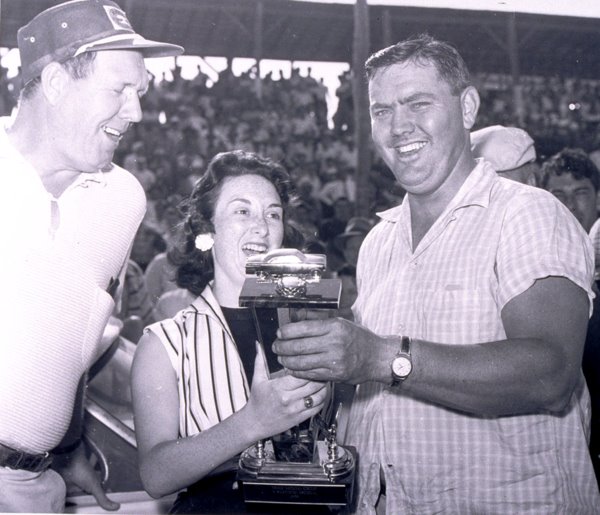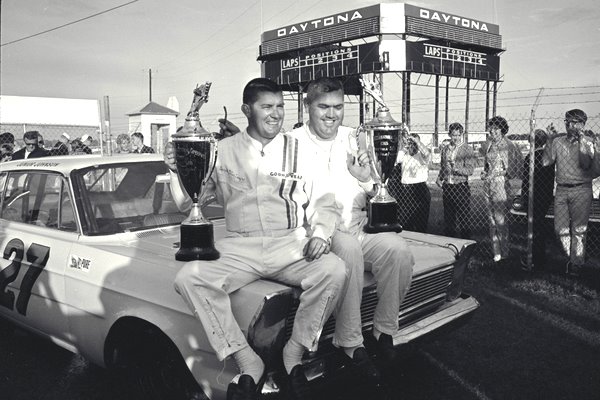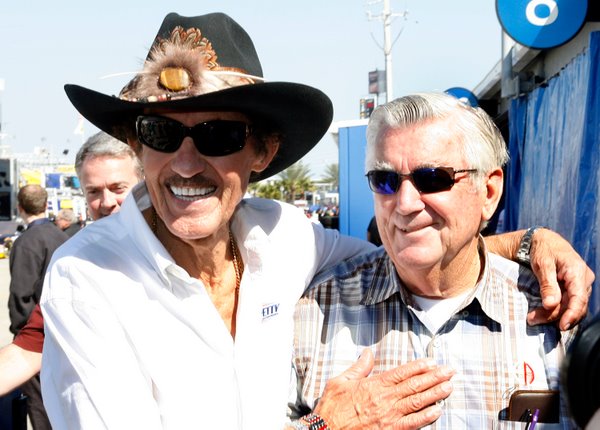Junior Johnson, returning to the track that gave so much heartache and heartbreak...and pondering NASCAR, as only ol' Junior can do
Ol' Junior always enjoyed a good laugh, particularly after he'd pulled a fast one (Photo: Getty Images for NASCAR)
By Mike Mulhern
mikemulhern.net
CONCORD, N.C.
When this New York City dude, in the ice cream white suit, showed up on his porch in Ingle Hollow that day back in 1965, well, Junior Johnson just didn't know quite what to make of him, this Tom Wolfe guy.
But what came out of those days in Wilkes County, and that Sunday at North Wilkesboro Speedway, helped dramatically change the face of NASCAR racing, when Wolfe's piece came out in Esquire…now considered one of the best-ever pieces of sports writing, of 'new journalism,' and a highly-colorful and distinctly definitive report on NASCAR racing: "Holy smokin' gumballs! Good God Almighty! Look out, here comes Junior Johnson, the Last American Hero, Yes!" http://bit.ly/177olZ
The Tom Wolfe piece (both men are the same age, now 78)? "I'll tell you one thing – he took it nationally. It was one of the biggest stories that has come along a long, long time. And he didn't get it from me, he got it from the people in Wilkes County," Johnson says. "'Cause I didn't tell him nothing.
"I told him to go out to all the little towns and little stores and talk to the people, and that's where he got it – he got it from the people."
And that piece still today reads like a classic Southern NASCAR charm.
It's been like old home week the past few days at the track that Bruton Smith built back in 1960 – the start of a long-running rivalry with the family that had just opened Daytona the year before, the Frances, who still rule the sport with iron fists.
And here was one of the classics, ol' Junior himself, fresh off his Yadkin County farm where he still farms, reminiscing about some of those good ol' days, and offering his two cents about what to do with this sport if he were the head of NASCAR: "I'd be hiring somebody to put some fans up in these stands." The sport right now "is lacking a little something, I'll agree with that.
"But times are tough and the fans are having a tough time going to the races. When the economy gets better, and the fans get to where they can afford it, the sport will come back."
Junior Johnson 'discovered' the draft at Daytona in 1960, and rode it to victory (Photo: Getty Images for NASCAR)
Perhaps one possibility to improve the racing itself – slowing the speeds. Jimmie Johnson hit 205 mph into the corners here in Thursday night qualifying; corner entry speeds at California are 209 mph. Too fast? "If you cut the speeds, they're going to bunch up. You'll have 30 cars on each straight," Johnson says.
But Johnson seems more perturbed about NASCAR's stringent rules enforcement, which handicaps, even handcuffs, crews, and hampers competition: "You have mixed emotions about it….it's like if your car is a little bit out of sync they won't let you run it. They need to give you a little more leeway on the cars."
Johnson's story of course is legend:
-- Moonshining, running the backwoods from the Wilkes County stills down to Winston-Salem, Greensboro and High Point. (Now Johnson has gone legit, selling tax-paid 'Midnight Moon,' available at your nearest North Carolina ABC store.)
-- Chillicothe, after he got caught at the still. The revenuers never caught him on the road. (At a 'reunion' up on Benny Parsons' Wilkes County spread the other night, where the late Parsons set up a winery, some of those very revenuers and Johnson and a bunch of old-timers talked up the stories. Like Johnson, firing up the still in the early morning with some coal and coke, before laying in the hardwood, got caught from behind, and swung that shovel around and hit the revenue man up side the head. Like the revenuers pointing out how sometimes it wasn't all that hard to find a still, because the liquor makers would pour the leftover slag in the nearby creek, and when cows, after munching on that stuff, started wandering across the highway half-drunk, well…….)
-- Junior Johnson is the man behind Dale Earnhardt's No. 3 – Johnson ran No. 3 himself, and when a young Richard Childress picked up the sport, he had Johnson as mentor and thus put the No. 3 on his doors too….and then along came Earnhardt….

Yes, that's Big Bill France Sr. on the left, congratulating Junior Johnson on a 1958 victory at North Wilkesboro (Photo: Ford Motorsports)
-- Johnson won 50 Cup races himself, from his first win in 1955 till he quit the wheel in early 1966, right after a 13-win 1965. Then he racked up six championships, three straight with Cale Yarborough and three more with Darrell Waltrip. He won the second Daytona 500 in 1960; he's 10th on NASCAR's all-time victory, and ninth on NASCAR's all-time pole winners. As car owner he won 139 races and six series championships, with men like LeeRoy Yarbrough, Cale Yarborough, Bobby Allison, Darrell Waltrip, Bill Elliott, Terry Labonte, Neil Bonnett, and Geoff Bodine.
-- Johnson, who first ran at Daytona on the sand in 1953, won the 1960 Daytona 500 by discovering the draft: "I had a slow car….but then, well, I didn't know what I had (in practice), but I knew I had something."
-- Johnson was the first man (in the 'modern era') to have multiple teams (and the first to discover that 'teammates,' like Waltrip and Bonnett, didn't always quite get along).
-- And Johnson had famous run-ins with just about everybody in the sport during his time, including the Frances, Sr. and Jr. "Me and him (Bill France Jr.) were sometimes about at fistfights….but then I'd make up with him – because I was getting ready for a cheatin' job and wanted to smother his face in it, you know.
"But look where we are today. Bill Jr. put down some groundwork that you just can't believe. And I never gave up on believing such a great job he did and how he was doing it.
"Now some of the things he did I didn't quite understand, but I lived with 'em, and it worked out. He did the right thing."

Junior Johnson (R) and Darel Dieringer in victory lane at Daytona (Photo: Ford Motorsports)
-- But perhaps most importantly, for this sport, Junior Johnson is the man behind R. J. Reynolds' move into the sport in the early 1970s, which literally helped save NASCAR racing from collapsing, during those dark days. "I needed a sponsor, and Reynolds had just pulled out of TV, so I knew they had money. I just wanted $800,000 for sponsorship….but they said they had $570 million freed up and they wanted to do something really big. So I immediately thought NASCAR." Johnson hooked up RJR execs with Bill France Jr., and the sport was suddenly reborn, with RJR's heavy marketing and promotion of NASCAR setting the stage for ESPN's arrival in the 1980s and in turn the sport's explosion into the national consciousness in the 1990s.
Recent back surgery has slowed Johnson: "I'd had a little bit of back surgery…and then I had to do it again…and got tired of that. So I've had my whole back done, from top to bottom. They put a titanium rod in….and carbon fiber plates…."
But he's not slowed much.
"He created a lot of heartburn for Ford Motor Company, that year he drove that Chevrolet and led about every race," NASCAR's Jim Hunter says of 1963.
Johnson also created heartburn for General Motors too, when he abruptly jumped from Chevy to Ford in the late 1988s, after he caught Chevy shipping some of his own specially designed engine cylinder heads to Chevy rival Rick Hendrick. "I caught them giving my stuff to other people," Johnson said. "Rick Hendrick was just getting into this sport, and Chevrolet wanted to equalize all its teams. But when they tried to equalize me, I just went to Ford."

Bobby Allison (R) celebrating his 1988 Daytona victory over son Davey. Car owner Junior Johnson says if Bobby Allison has stuck with him, instead of striking out on his own, Petty's record of 200 NASCAR wins would instead belong to Allison himself (Photo: Getty Images for NASCAR)
"I was out with Jack Roush the other day, and I told him if he needed any help, I'd be willing. And he said he could use it," Johnson added with a laugh.
But Johnson now is quick to praise Hendrick's stars Jimmie Johnson and crew chief Chad Knaus, saying it wouldn't surprise him a bit for them to win a record-breaking fourth straight championship, calling Johnson "the best driver on the circuit" and Knaus "the best mechanic in the sport.
"You can't beat a guy when he's on top of his game."
So why did Johnson quit in 1966? Well, racing was a deadly game back then. In 1964 Joe Weatherly was killed at Riverside, Billy Wade was killed tire testing at Daytona, and Fireball Roberts died after a fiery crash here in the 600.
But for Johnson it wasn't the danger, it was the lack of challenges at the wheel. For all his talent as a driver, he positively reveled in his talent as an innovator…and in tricking NASCAR inspectors. Smokey Yunick may be part of the NASCAR legend at all that, but Junior Johnson kept at it much, much longer. NASCAR's new Hall of Fame (Johnson is one of the first five picks) may need a Junior Johnson Wing to hold all the trick parts and pieces from his era.
What does Johnson think his strongest attribute is? "I think I can see through things that other people can't. I can see 'the beyond,' and I use that a lot.
"Now you look at David Pearson's record (105 tour wins, three championships), and Cale Yarborough's (83 tour wins, three championships), and Darrell Waltrip's (84 wins, three championships)….I could have stayed on the driving side (instead of retiring in 1966) and probably beat every one of them, because I won my (50) races faster than they won theirs," Johnson said.
"But I moved on to a different division of the sport…."
His biggest wins? The Daytona 500 and Southern 500, obviously. "But this place here hurt me the worst – I wanted that 600, in '63, and I had it, but somebody threw a beer bottle on the backstretch, I cut a tire down…."
As a car owner, Johnson wasn't just passively on the sidelines. He was over-the-wall as jackman until he turned 58. Slinging those old 40-pound steel jacks around (not one of today's light-weigh jacks) is one of the legendary Johnson photos. Did he ever use that distinctive technique to hit someone? "I wanted to get those inspectors every time I went out," Johnson said with a laugh.

Back in '72, when Richard Petty and Bobby Allison (R) were feuding -- like seriously feuding -- a picture like this could never have been taken. And just how much time has mellowed these two about all that, well..... (Photo: Getty Images for NASCAR)
Cale Yarborough was probably Johnson's favorite driver to work with. "Cale always gave you everything he had, no matter how the car was working. If he'd stayed with me (Yarborough left in 1980, to run a part-time schedule), we could have won seven or eight championships."
And Bobby Allison was easily one of Johnson's toughest drivers to deal with, as a car owner. The two had one brilliant season together, 1972, winning 10 races and coming within a hair of the championship. But then, after those run-ins with Richard Petty, which got very ugly, they split, and not amicably. "If Bobby Allison had stayed with me, Richard Petty's record (200 wins) wouldn't be Richard Petty's record, it would be Bobby Allison's record. But Bobby wanted to go out on his own and try to do better…I did the same thing, but I sort of succeeded in what I did, and he had a hard time with what he did."
Some of the men who worked for Johnson over the years thought they were learning all the tricks of the trade and then tried to go off on their own. Legendary crew chief Herb Nab, for one, the sport's first $50,000 a year crew chief, was hired by Harry Ranier after that 1977 championship season. And there were others who found out, to their chagrin, that just knowing all the right people and the right phone numbers to call wasn't enough – if it wasn't Junior Johnson on the other end of the line, the phone calls simply didn't go through.
Finally Johnson decided to hang it all up after the 1995 season, and retired to his farm.
When Johnson told Bill France Jr. he was going to call it quits, France tried to talk him out of it: "Billy Jr. told me I couldn't quit, because I was 'committed' to the sport. I told him no, I was just a 'participant.' Like when it comes to bacon and eggs, that chicken is just a participant…but that hog, now he's 'committed.'"
So can he now finally reveal some of the tricks behind that 1985 All-star winning engine, that amazingly blew up just as Waltrip crossed the finish line as winner? Well, maybe, maybe not: "I 'timed' it for 10 laps (the final 10 laps). I just picked up a screwdriver and a hammer and walked over to the distributor and knocked about 10 degrees of timing in that thing…and that's all it needed to run that last 10 laps. But you ain't going to last over 10 laps."
And ol' DW really didn't just clutch it, to keep it out of the hands of post-race inspectors? Well, Junior Johnson doesn't reveal everything…..
So what would Junior Johnson like, eventually, as his epitaph?
Johnson laughed and pondered a moment, and replied: "'He didn't cheat as much as everybody thought he did.'"
And he laughed again.
"But that'd be a lie too….more than they thought I did."
And he laughed yet again.
Junior Johnson (R) and long-time Charlotte promoter Humpy Wheeler, at NASCAR's Hall of Fame (Photo: Getty Images for NASCAR)
© 2010-2011 www.mikemulhern.net All rights reserved.
Web site by www.webdesigncarolinas.com







Chevy's Hendrick Favoritism
Junior Johnson mentioned Chevy's Hendrick favoritism - he was just one of many victims - the Pontiacs (Chevy took over control of their program in 1992 with the Motorsports Technology Group), the RAD cars (Childresss, Petree, and DEI), Morgan-McClure, basically anyone who ran GM cars and weren't getting bribed by Hendrick.
The most famous shot of Johnson slinging the jack was at Talladega in 1978 - he knocked one of the pit officials over as he raced around to the left side of Cale's Oldsmobile.
Post new comment